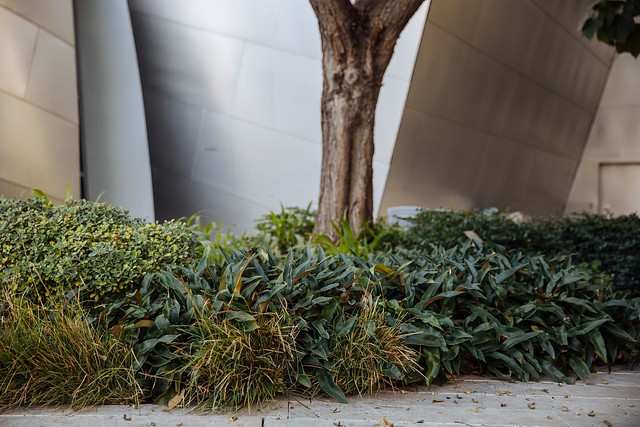Sometimes I take the Metro train from Long Beach to visit family near Downtown Los Angeles. Yesterday Mitch and his daughter Domino picked me up at the usual stop on Grand Avenue, and we explored the Broad Art Musem and MOCA a bit before heading outdoors for some running room for a two-year-old. I wanted to check the progress on the petite but powerful Disney Concert Hall garden. It had been years since I visited, and I was curious as to how the plantings were holding up in this pass-through space known as the Blue Ribbon Garden.
But the fountain is always Domino’s destination. It is a strikingly fussy, sentimental feature against the backdrop of Gehry’s sleek leviathan of swooping stainless steel panels. But unlike the competing visions of Robert Irwin and Richard Meier for the Getty garden, this little garden was designed by Frank Gehry himself. (“Meier was aghast at Irwin’s proposal; it posited an all-out argument against the permanence and eternal unities that Meier’s architecture symbolized. Both men were directed to collaborate together. Not surprisingly, things did not go well.” When Fountainheads Collide)
The erythrina, dombeya and bauhinia trees have claimed the garden for shade now, which is quietly carpeted with plants tolerant of the dappled light, including liriope and lomandra. I knew the now-closed Worldwide Exotics nursery had provided plants for the garden and believe the extensive planting of pyrrosia is owed to them.
The tropical and subtropical trees now dominate the smoothly undulating plantings, creating a serene gardenscape to wander through. But what were the fiery spikes interrupting this tranquil scene in the month of February?
I’ve never grown Scadoxus puniceus, a South African member of the Amaryllidaceae, but to me it has the look of a plant that takes forever to mature to blooming size and may or may not take a year off depending on whether it has a proper dry rest at the precisely required time — aka tricky. Or perhaps it’s dead easy. Whatever the case, a mature stand in full bloom was an unexpected sight arising out of the surrounding sea of tranquility.











The photos of the Scadoxus under the Bauhinia are striking, Denise! I never much cared for the rose fountain but it gained a lot of charm with little Domino looking down into it. As I recall, I’ve been there just once and, as I no longer worked downtown when it first opened, I’m not even sure what may have brought me there. I wonder if Loree’s aware that there’s a plethora of Pyrossia there? She might be interested in a visit.
Your grand daughter is adorable. I quite like the fountain juxtaposed against the harsh modern architecture. Softens it. With the story behind the fountain it gives it some interesting history with a sentimental feel. It looks like you had a lovely day out with your family.
Thanks for sharing the story behind the fountain, that makes it almost likeable. As for the pyrrosia, just looking at your photo (I will plan to see this in person, someday!) I’d say it’s P. sheareri not P. lingua. It would be the most robust version of P. lingua I’ve ever seen if that’s what it is. Also, you should try Scadoxus puniceus, it really is dead easy!
@Kris, I kept thinking the garden was bigger. Maybe it looks smaller because the trees have grown in. There may be an additional courtyard for special events, not open to the general public.
@Elaine, the fountain has a sign that says it’s a gift of Lilian’s grandkids, so I wasn’t sure who was responsible for it, but the official website says it’s Gehry’s work.
@Loree, I’ve only seen P. lingua available locally and very seldomly so assumed this ID. Mine labeled lingua came from Worldwide Exotics a few years ago, and they look as robust as this planting, so could be a case of mistaken ID. There’s so much conflicting info on growing scadoxus, keep it dry for certain periods, yet I’m pretty sure this area gets constant irrigation judging by surrounding plants. I’ll continue to enjoy it wherever and whenever I stumble upon it!